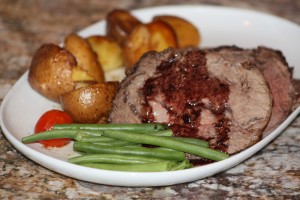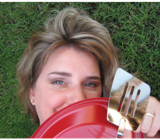Fabulous Sister-in-Law Chef Sandy is back!
She’s got a great recipe for a Prime Rib Roast (which we devoured at Christmastime — see photos) and Yorkshire Pudding.

This is a great idea for a wonderful Easter dinner. Seriously, it’s coming up. Follow her tips to the letter and you won’t go wrong!
That’s how I do it anyway.
Enjoy!
Prime Rib Roast and Yorkshire Pudding
Although traditionally thought of as a Christmas holiday time dish, I see no reason why not to make Yorkshire Pudding with a Prime Rib Roast for Easter. It is a good way to use up some eggs that we are going to decorate, because my kids don’t like hard boiled eggs. Here is my plan for the eggs:
Take the raw eggs required for the recipe and blow out the insides into a clean bowl.
- Carefully punch a hole in each end of the egg with a sharp knife, and work the hole in the bottom to be about a ¼ inch in diameter.
- Blow hard into the smaller hole to force the egg out into your clean bowl from the larger hole.
- Rinse the eggs under running water, and then carefully bathe them in a bowl with about ¼ cup white vinegar and a few cups of water.
- Take the egg shells out of the water, let them dry on paper towels and shake any water out of the inside.
- To make sure they are really dry, let them sit out for a few hours before decorating with markers, stickers or whatever your imagination leads you to. Glitter would be amazing.
- To hang the eggs, there are two options:
- Use a fine ribbon threaded onto a tapestry needle and feed the ribbon straight thru the egg to the other side and tie a knot on the far side of the egg (usually the larger end of the egg looks better on the bottom.) You can also put a large bead on the ribbon to use as a stop-knot.
- Wrap a fine thread around half of a toothpick or wooden match. Feed the small piece of wood thru the small hole at the top of the egg and then shake it a little so that it sits perpendicular to the opening and will support the egg.
- Hang from pretty any branches or window locks to enjoy.
- These eggs, carefully treated, will last forever. Keep the clean egg carton to put your finished creations in.
Of course Yorkshire Pudding is not really pudding, in the American sense. More like a puffy bit of soufflé/bread made with beef drippings. This is a very traditional accompaniment to a Rib Roast, probably due to the amount of drippings which do make themselves available with this dish. Prepare the batter for the puddings using the recipe below.
The tricky thing about these puddings (or any soufflé type item) is the timing. They are beautiful and showy when they are served immediately upon removal from the oven, but you don’t have a lot of wiggle room. They will deflate and will be a disappointment if you have to hold them. Have your other last minute things done and only put these in the oven when the roast is out of the oven and resting. While the puddings bake, ice your glasses and pour your beverages. Have the appetizer courses started and plan to have everyone at the table ready to enjoy their Prime Rib Roast and Yorkshire Puddings the moment they get out of the oven. For a rare roast, count on serving about two hours after you start the roast. For medium or more done, adjust your timing accordingly.
The Prime Rib Roast 101 with Yorkshire Pudding recipe below is courtesy of The Martha Stewart Living Cookbook, First Edition.
For the pudding:
2 cups all-purpose flour
1 teaspoon kosher salt
6 large eggs
2 ½ cups milk
Sift together flour and salt. Place in a large bowl; make a well and place the eggs in the center. Slowly whisk the eggs into the flour mixture until a smooth paste forms. Gradually whisk in ½ cup milk and then the remaining 2 cups of milk. Cover with plastic wrap and chill at least 4 hours or overnight.
For the roast:
3# prime-rib roast, first cut, trimmed and tied, at room temperature (set out 2 hours before cooking)
2 tbsp kosher salt
1 tbsp freshly ground black pepper
3 short ribs, tied
1 ½ cups dry red wine
Preheat oven to 450 degrees F, with oven rack on the lowest level. Rub the roast all over with the salt and pepper, trying to get an even coating. Transfer to a heavy 13 x 16 metal roasting pan, arranging the meat fat side up, on top of the short ribs. The ribs will act as a roasting pan and will flavor the drippings.

Cook 20 minutes, then reduce the heat to 325 and continue cooking until an instant read thermometer reads 115 for rare. The temperature of the roast will increase 10-15 degrees after removing from the oven, so keep this in mind if you want a different doneness. For rare, this will take about 1 hour and 25 minutes. Use a probe thermometer or check every 10 minutes after this point to insure you do not over cook.
Let the roast rest uncovered for 30 minutes in a warm spot. Tenting the roast will cause the crust to get soggy. Return oven temperature to 425.
Pour fat and drippings into a fat separator or glass measuring cup, set aside to let fat separate from meat juices. Put roasting pan over medium high heat and add red wine to deglaze the pan. Cook about 6 minutes, until reduced by half. Place a fine sieve over a medium bowl and strain the sauce into the bowl. Do not clean the pan.
Making the Yorkshire Pudding:
Place ¼ cup of reserved fat from the roast into the roasting pan, and place it in the hot oven until very hot, about 5 minutes. Remove the batter from the refrigerator and whisk well; quickly and carefully pour the batter into the hot pan and cook until the Yorkshire Pudding is crisp and golden, about 25 minutes. Make sure it is nicely browned before removing it; it will deflate more quickly if it is not thoroughly cooked. Cut each person a wedge of warm pudding with the crispy edge, which will help it hold its shape. Transfer the red wine sauce to a gravy boat and serve with the Prime Rib Roast and Yorkshire Pudding.
Stay tuned tomorrow to find out what to do with those Prime Rib Roast leftovers. Your family will love you for it! – Dena




